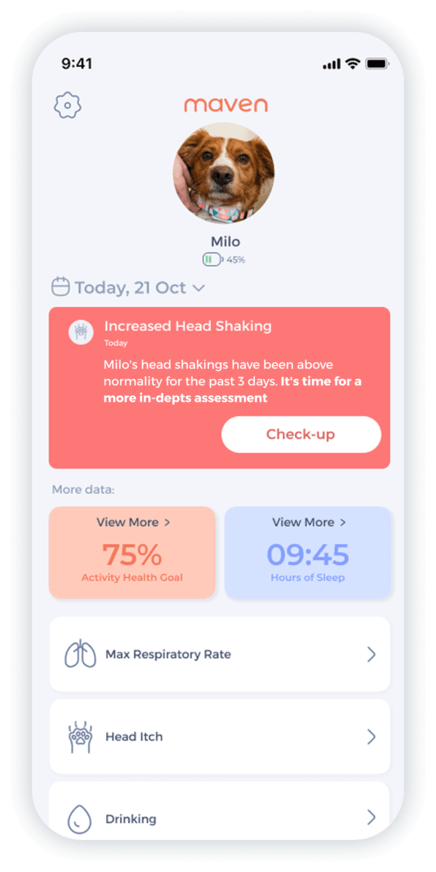Early Signs of Heart Disease in Dogs That Most Pet Parents Miss (Vet Verified)
When it comes to heart disease, the most crucial signs are often subtle, easily mistaken for just “getting old” or a simple off day. Recognizing these early clues of heart disease in dogs is the most important step you can take. With early detection and adequate treatment, your furry friend can live a comfortable life.
In this vet-verified guide, we will walk you through the subtle indicators, from changes in energy to nighttime restlessness that warrant a call to your vet.
Key Takeaways
- Look for Subtle Changes: The earliest signs are often a quiet shift in behavior, such as decreased enthusiasm for play or a slight increase in the sleeping/resting respiratory rate (SRR).
- Don’t Dismiss Fatigue: Reduced tolerance for exercise (dog heart symptoms) is a common early sign, often mistaken for normal aging.
- Breathing Rate Matters: Monitoring your dog’s resting respiratory rate (under 30 breaths per minute) is a crucial indicator of heart issues.
- Early Detection is Crucial: Diagnosing before severe symptoms occur allows for the most effective treatment to slow disease progression.
What Is Heart Disease in Dogs?

Heart disease in dogs refers to any condition that impairs the heart’s ability to pump blood effectively throughout the body.
The two most common forms are:
- Chronic Valvular Disease (CVD), or Myxomatous Mitral Valve Disease (MMVD): This is the most common heart problem. It occurs when the heart valves (most often the mitral valve) degenerate and leak, causing blood to flow backward, which eventually strains and enlarges the heart.
- Dilated Cardiomyopathy (DCM): The heart muscle thins and weakens, causing the chambers to enlarge and lose their ability to pump blood forcefully.
In both cases, the heart eventually becomes overworked, leading to congestive heart failure (CHF), where fluid builds up in the lungs (pulmonary edema) or abdomen (ascites).
Early Signs of Heart Disease in Dogs Most Pet Parents Miss
“The earliest signs of heart disease in dogs are often behavioral changes in energy, appetite, or breathing. The sooner they’re noticed, the better the long-term prognosis.” — Carolina Domingues, DVM, Veterinarian at Maven Pet.
The first clues of a dog’s heart condition are often so mild that they go unnoticed or are attributed to other factors. Keep an eye out for these behavioral changes:
Reduced Exercise Tolerance
- Your dog tires more quickly on walks, play, or during vigorous activity.
- You may notice it takes them a longer time to recover (pant less heavily, slow heart rate) after exercise.
Changes in Resting Respiratory Rate
- Normal RRR for dogs is typically under 30 breaths per minute.
- Any sustained, resting rate above this range is a strong indicator of fluid in the lungs.
Restlessness or Change in Sleep Position
- Your dog might shift positions frequently at night, unable to settle into a comfortable rest.
- They may avoid lying on their side and instead sleep in a “sphinx” or sitting position with their head elevated. This posture helps them breathe easier if fluid is collecting in their lungs.
Decreased Appetite or Mild Weight Loss
- In the early stages, subtle changes in appetite or unexplained, gradual weight loss can occur. This is often due to the heart condition affecting metabolic processes.
“I got the Maven sensor for my 14-year-old Chihuahua mix with heart and trachea issues. It gave me back peace of mind – I can track her RRR, BPM, drinking, and activity anytime and know instantly if something’s wrong. Highly recommend!”

★★★★★
Chiara De Luca
Titti
Dog Heart Symptoms You Should Never Ignore
As a dog heart condition progresses, more serious signs of congestive heart failure will become apparent. These are not subtle and warrant an emergency trip to the vet.
- Persistent coughing or gagging
- Difficulty breathing
- Fainting or collapse
- Pot-bellied appearance
Dog Heart Disease Signs That Develop Over Time
When you miss early signs, the disease moves into more symptomatic stages. Recognizing this progression can be life-saving.
Ask yourself these questions:
Why Is My Dog Not Exercising as Much as Before?
When a dog’s heart function is impaired, there is a reduced blood flow. This causes a decrease in energy, so the dog won’t just be less playful – they won’t be able to tolerate their previous level of exercise.
What Does a Cardiac-Related Cough Sound Like?
A cough related to heart disease is often a soft, persistent, non-productive hack or gag. It may sound like your dog is trying to clear their throat.
How Vets Diagnose a Dog Heart Condition

If you suspect your dog has heart issues, your vet will perform a thorough examination, which typically includes:
- Listening to your dog’s heart for a heart murmur (a whooshing sound) and checking the lungs for fluid.
- Take chest X-rays to assess the size and shape of the heart and check for fluid accumulation in the lungs.
- Do an ultrasound of the heart to measure chamber size, valve function, and pumping efficiency.
- Relevant blood tests.
What Pet Parents Can Do at Home
While only a vet can diagnose and treat heart disease, you play a vital role in monitoring your dog’s health.
Here are the key actions you can implement at home:
- Monitor the resting respiratory rate (RRR)
- Track recovery time after play or walks
- Record coughing and behavior logs, such as water and food intake, and resting posture
The best way to implement these actions at home is by using a dog health tracker like the Maven Pet Health Monitor. With a specialized device, you ensure that every minor symptom gets registered and is accessible to you and your vet.
How the Maven Pet Health Monitor Helps Detect Early Cardiac Changes
With the Maven Pet Health Monitor, a pet health tracker designed to monitor and automatically log the very changes that correlate with early heart conditions, you can be sure you won’t miss the subtle signs.


Monitor heart rate, respiratory rate, activity & rest, drinking, itch behavior.
- Heart Rate and Rest Monitoring: Using a device that tracks heart and breathing rate empowers you to detect consistent increases that may signal a cardiac issue.
- Activity Reduction: The tracker logs your dog’s daily activity level into Maven’s pet health app. A measurable and sustained drop in activity or reduced exercise intensity can flag a problem before you consciously notice your dog’s lack of energy.
- Trend Analysis: The monitor provides a baseline, allowing it to quickly alert you to trends in your dog’s behavior. This provides objective data to share with your vet, making it an invaluable tool.
Takeaways Recap
- Subtle Behavioral Shifts are Key: The very first signs of a dog’s heart condition are often quiet, easily overlooked changes in behavior.
- Monitor Breathing Rate: Learning to measure your dog’s resting respiratory rate (RRR) is crucial.
- Don’t Ignore Lack of Energy: If your dog is tiring faster on walks or taking longer to recover after play, don’t dismiss it as just aging.
- Act on Serious Symptoms: Symptoms like a persistent, dry cough, excessive panting at rest, or fainting require immediate vet attention.
- Early Detection Improves Prognosis: Diagnosing heart disease in its early, less symptomatic stages allows vets to start treatments that can significantly slow the progression of the disease and improve your dog’s quality of life.
- Technology Helps: Tools like the Maven Pet Health Monitor can objectively track subtle changes in heart and breathing rate, activity, and rest, helping pet parents detect problems earlier than relying on observation alone.
Maven Pet focuses on improving the quality of life of our pets with technology, using artificial intelligence (AI) to enable proactive pet care. By accurately collecting and monitoring pet data 24/7 and flagging any irregularities, Maven Pet empowers pet parents and veterinarians to stay ahead of potential health issues, ensuring the well-being and longevity of our beloved companions.




